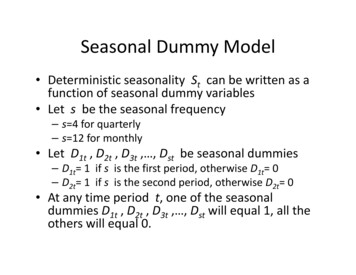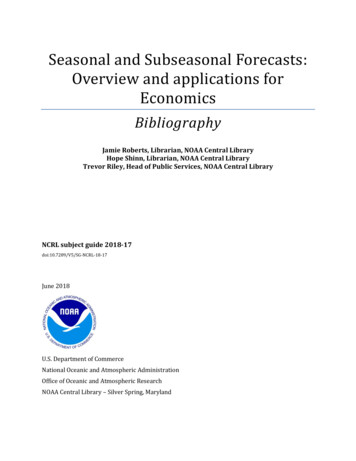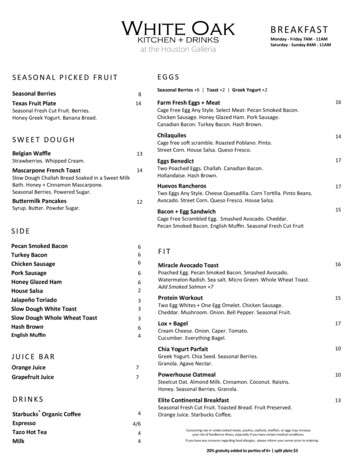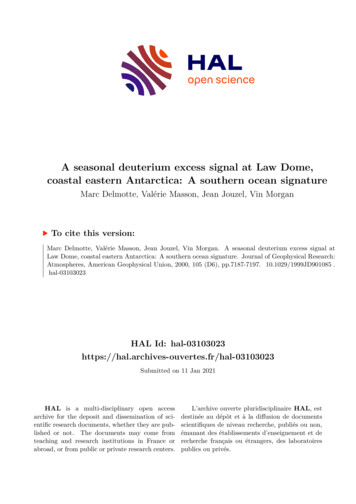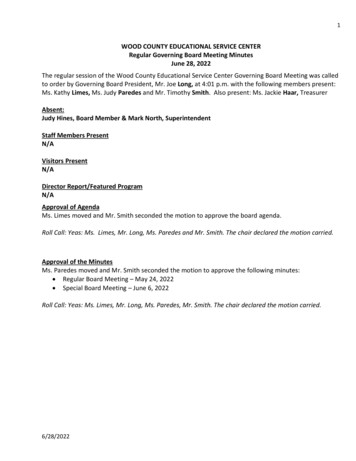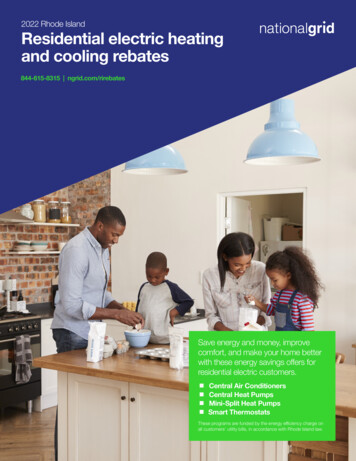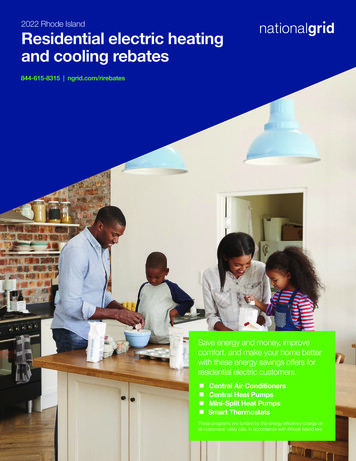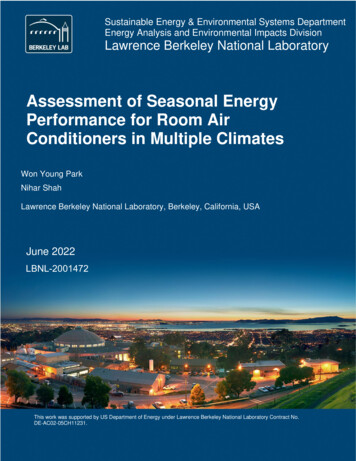
Transcription
Sustainable Energy & Environmental Systems DepartmentEnergy Analysis and Environmental Impacts DivisionLawrence Berkeley National LaboratoryAssessment of Seasonal EnergyPerformance for Room AirConditioners in Multiple ClimatesWon Young ParkNihar ShahLawrence Berkeley National Laboratory, Berkeley, California, USAJune 2022LBNL-2001472This work was supported by US Department of Energy under Lawrence Berkeley National Laboratory Contract No.DE-AC02-05CH11231.Assessment of Seasonal Energy Performance for Room Air Conditioners in Multiple Climates 1
DisclaimerThis document was prepared as an account of work sponsored by the United States Government.While this document is believed to contain correct information, neither the United StatesGovernment nor any agency thereof, nor The Regents of the University of California, nor any oftheir employees, makes any warranty, express or implied, or assumes any legal responsibility forthe accuracy, completeness, or usefulness of any information, apparatus, product, or processdisclosed, or represents that its use would not infringe privately owned rights. Reference hereinto any specific commercial product, process, or service by its trade name, trademark,manufacturer, or otherwise, does not necessarily constitute or imply its endorsement,recommendation, or favoring by the United States Government or any agency thereof, or TheRegents of the University of California. The views and opinions of authors expressed herein donot necessarily state or reflect those of the United States Government or any agency thereof, orThe Regents of the University of California.Ernest Orlando Lawrence Berkeley National Laboratory is an equal opportunity employer.Copyright NoticeThis manuscript has been authored by an author at Lawrence Berkeley National Laboratoryunder Contract No. DE-AC02-05CH11231 with the U.S. Department of Energy. The U.S.Government retains, and the publisher, by accepting the article for publication, acknowledges,that the U.S. Government retains a non-exclusive, paid-up, irrevocable, worldwide license topublish or reproduce the published form of this manuscript, or allow others to do so, for U.S.Government purposes.
AcknowledgementsThe work described in this study was funded by the National Philanthropic Trust.The authors would like to thank reviewers for their review of Park et al. 2021, Park et al. 2019,and UNEP 2019a in which the framework and methodology described in this report have beenapplied.This report was also reviewed by Greg Rosenquist of Lawrence Berkeley National Laboratoryand Dr. Wonuk Kim of the Korea Refrigeration and Air-conditioning Assessment Center(KRAAC).Assessment of Seasonal Energy Performance for Room Air Conditioners in Multiple Climates i
AbstractThis report provides a general approach for adopting a seasonal energy efficiency metric byexamining the climate-specific temperature bin distribution for air conditioner use, the seasonalenergy efficiency results according to International Standards Organization (ISO) 16358 byclimate region, and the relationships in seasonal energy efficiency across regional metrics. Thisapproach could make the seasonal efficiency metric values comparable with those from othercountries with standards consistent with ISO 16358. Policy action and market transformationcan be accelerated and effectively harmonized with other regional or international efforts byadopting a seasonal energy efficiency metric. The framework and methodology described inthis report have been applied in the following publications: Shaffie et al. 2022, Park et al. 2021,Park et al. 2019, and UNEP 2019a.Assessment of Seasonal Energy Performance for Room Air Conditioners in Multiple Climates ii
Table of ContentsAcknowledgements . iAbstract . iiTable of Contents . iiiList of Acronyms . iiiList of Reference Standards . ivList of Figures . vList of Tables. v1. Cooling seasonal performance for air conditioners . 12. Developing outdoor temperature bin hours for AC use . 43. Evaluating the efficiency performance of ACs . 84. Estimated energy consumption from efficiency performance . 11References . 19Appendix A. Climate Data . 21List of U4EUECVSDWEERAir ConditionerAmerican Society of Heating, Refrigerating and Air-Conditioning EngineersCooling CapacityCooling Degree-Day Base 10 CCooling Seasonal Energy ConsumptionCooling Season Performance FactorEnergy-Efficiency RatioFixed-Speed DriveHeating Degree-Day Base 18 CMinimum Energy Performance StandardSeasonal Energy Efficiency RatioUnited for EfficiencyUnit Energy ConsumptionVariable-Speed DriveWeighted Energy Efficiency RatioAssessment of Seasonal Energy Performance for Room Air Conditioners in Multiple Climates iii
List of Reference StandardsANSI and ASHRAE (American National Standards Institute and the American Society ofHeating, Refrigerating and Air-Conditioning Engineers). 2013. Climatic Data for BuildingDesign Standards. ANSI/ASHRAE Standard 169-2013.India Bureau of Energy Efficiency. 2015. Schedule 19 Variable Capacity Air Conditioners.ISO (International Organization for Standardization). 2013. ISO 16358-1:2013 Air-cooled airconditioners and air-to-air heat pumps — Testing and calculating methods for seasonalperformance factors — Part 1: Cooling seasonal performance factor.ISO 16358-2:2013 Air-cooled air conditioners and air-to-air heat pumps — Testing andcalculating methods for seasonal performance factors — Part 2: Heating seasonalperformance factor.ISO 16358-3:2013 Air-cooled air conditioners and air-to-air heat pumps — Testing andcalculating methods for seasonal performance factors — Part 3: Annual performance factorISO 16358-1: 2013/Amd:2019 Air-cooled air conditioners and air-to-air heat pumps — Testingand calculating methods for seasonal performance factors — Part 1: Cooling seasonalperformance factor — Amendment 1.Japanese Standards Association. 2013. JIS C 9612:2013. Room Air Conditioners.Korean Standards Association. 2017. KS C 9306:2017. Air conditioners.The Standardization Administration of the People's Republic of China. 2004. GB/T 7725-2004.Room air conditioners.The Standardization Administration of the People's Republic of China. 2019. GB 21455-2019.Minimum allowable values of the energy efficiency and energy efficiency grades for variablespeed room air conditioners.Assessment of Seasonal Energy Performance for Room Air Conditioners in Multiple Climates iv
List of FiguresFigure 1. Outdoor temperature distribution of nine hot/warm climate regions . 4Figure 2. Annual outdoor temperature bin hours (brown) and temperature bin hours assumed forAC use in 0A (blue) . 6Figure 3. Annual outdoor temperature bin hours (brown) and temperature bin hours assumed forAC use in 0B (blue) . 6List of TablesTable 1. Test Requirements and Options for Evaluating AC Cooling Seasonal Energy Efficiency. 2Table 2. Parameters Used in This Analysis for ISO CSPF Calculation with ISO 16358:1-2013. 3Table 3. Parameters Used in This Analysis for ISO CSPF Calculation with ISO 16358:12013/Amd: 2019 . 3Table 4. Summary of Outdoor Temperature Bin Hours Used in the ISO CSPF Calculation inAccordance with ISO 16358-1:2013 . 7Table 5. Summary of outdoor temperature bin hours used in the ISO CSPF calculation inaccordance with ISO 16358-1: 2013/Amd: 2019 . 7Table 6. Modeled specifications of the eight ACs . 8Table 7. Calculated Efficiency and Energy Consumption of the Four VSD ACs With a Two Set ofConfigurations . 9Table 8. Calculated Efficiency and Energy Consumption of the Four FSD ACs . 10Table 9. Calculated Efficiency and Energy Consumption of the Three VSD ACs for Egypt . 10Table 10. Estimated UECs by Efficiency for VSD ACs . 11Table 11. Estimated UECs by Efficiency for FSD ACs . 14Table 12. Estimated UECs by Efficiency for VSD ACs . 17Table 13. Estimated UECs by Efficiency for FSD ACs . 18Table A1. Criteria of Climate Region and Weather Stations Included in this Analysis . . 20Table A2. Countries by Climate Region . .21Table A3. Temperature Bins for Calculating ISO CSPF (ISO 16358-1:2013) . .22Table A4. Temperature Bins for Calculating ISO CSPF (ISO 16358-1:2013/Amd: 2019) . .23Assessment of Seasonal Energy Performance for Room Air Conditioners in Multiple Climates v
1. Cooling seasonal performance for air conditionersOver the past decades, air conditioner (AC) manufacturers have improved the performance andreduced the costs of AC systems. Variable-speed drive (VSD) compressors (also known asinverter-driven) enable an AC unit to respond to changes in cooling requirements by operating atfull or partial loads. This flexibility improves performance and reduces refrigerant flow ratescompared to the performance and refrigerant flow of conventional ACs with fixed-speed drive(FSD) compressors that cycle on and off (Shah et al. 2013).Along with this trend toward VSD ACs, seasonal energy efficiency ratio (SEER) metrics havebeen designed to estimate AC performance based on part- and full-load operation at multipletemperature conditions, depending on climate. Since local climatic conditions affect the amountof time an AC operates at part or full load, climate-specific weighting is used in calculating SEER.This provides a more representative measure of performance than the traditional energyefficiency ratio (EER) —defined as the ratio of the total cooling capacity (CC) to the effectivepower input to the device at any given set of rating conditions (Park et al. 2017). Climate-specificweighting is used to calculate an AC seasonal energy efficiency that represents performancemore realistically than the traditional EER. Seasonal efficiency metrics consider the impact ofvariations in outdoor temperature on cooling load and energy consumption. They require (oroptionally allow) multiple test points to compute a seasonally weighted average efficiency torepresent how an AC would perform over a typical cooling season in a representative buildingtype with typical operating characteristics (ANSI and ASHRAE 2013, Park et al. 2020).The difference in seasonal efficiency metrics is primarily due to the outside temperature profilesused to aggregate steady-state and cyclic ratings into a seasonal efficiency value, and the waysthe metric evaluates performance at part-load operation. Specific parameters in each regionalstandard account for AC performance at part-load and/or lower-temperature operation in theefficiency metric. The cooling seasonal efficiency metrics used in Brazil, China, Japan, India,South Korea, and countries in Southeast Asia are equivalent to, or largely consistent with, ISO16358-1:2013-defined metrics. Brazil, China, Japan, India, and South Korea use their regionspecific outdoor temperature bin hours. Southeast Asian countries use the ISO referencetemperature bin hours (Park et al. 2019, Park et al. 2020, Park et al. 2021). Table 1 shows optionsfor evaluating cooling seasonal energy-efficiency using ISO 16358-1:2013 or regional standards.Assessment of Seasonal Energy Performance for Room Air Conditioners in Multiple Climates 1
Table 1. Test Requirements and Options for Evaluating AC Cooling Seasonal Energy EfficiencyOperating conditionaFull capacity andpower inputHalf or intermediate capacityand power inputbMinimum capacity andpower inputFull capacity andpower inputHalf or intermediate capacityand power inputMinimum capacity andpower inputOutdoor drybulbtemperature35 C29 CFSDVSDRequiredRequiredNot applicableRequiredNot applicableRequired/optional/not considereddRequired/optionalbOptionalcNot applicableOptionalcNot applicableOptional/not considereddaThe ISO 16358-1:2013, JIS C 9612-2013 (Japan), and GB/T 7725-2004 (China) standards specify cooling halfcapacity at outdoor temperature t to be 50% ( 5% or 0.1 kW) of full capacity at t at full-load operating conditions. InSouth Korea, the KS C 9306:2017 standard is based on full- and minimum-capacity tests. The intermediate-capacitytest can be done at a level between the full and minimum capacities if the minimum capacity is less than 50% of thefull capacity.b While ISO 16358 requires full-load performance at the lower temperature to be measured, this is calculated inregional standards by using predetermined equations as below:𝐶𝑎𝑝𝑎𝑐𝑖𝑡𝑦(29 ) 𝐶𝑎𝑝𝑎𝑐𝑖𝑡𝑦(35 ) 1.077; 𝑃𝑜𝑤𝑒𝑟 𝑖𝑛𝑝𝑢𝑡(29 ) 𝑃𝑜𝑤𝑒𝑟 𝑖𝑛𝑝𝑢𝑡(35 ) 0.914c Performance at the lower temperature can be calculated by using predetermined equations as below:ISO, China, India, Japan: 𝐶𝑎𝑝𝑎𝑐𝑖𝑡𝑦(29 ) 𝐶𝑎𝑝𝑎𝑐𝑖𝑡𝑦(35 ) 1.077; 𝑃𝑜𝑤𝑒𝑟 𝑖𝑛𝑝𝑢𝑡(29 ) 𝑃𝑜𝑤𝑒𝑟 𝑖𝑛𝑝𝑢𝑡(35 ) 0.914South Korea: 𝐶𝑎𝑝𝑎𝑐𝑖𝑡𝑦(29 ) 𝐶𝑎𝑝𝑎𝑐𝑖𝑡𝑦(35 ) 1.077; 𝑃𝑜𝑤𝑒𝑟 𝑖𝑛𝑝𝑢𝑡(29 ) 𝑃𝑜𝑤𝑒𝑟 𝑖𝑛𝑝𝑢𝑡(35 ) 0.864d The SEER calculation in India (ISEER) does not consider minimum capacity tests.ISO 16358 suggests the minimum capacity test at 29 C to be conducted first and allows the minimum capacity testat 35 C to be measured or calculated by using default values. China (for units with CC 7.1 kW) and South Koreastandards require the minimum capacity test at 35 C and allow the minimum capacity test at 29 C to be calculatedby using default values.Source: Authors’ work based on ISO 16358:2013; China’s GB/T 7725-2004, GB 21455-2019; India’s Schedule 19;Japan’s JIS C 9612:2013; South Korea’s KS C 9306:2017.Source: Park et al. (2020); Park et al. (2019)Table 2 shows the parameters used in this analysis for the ISO cooling season performancefactor (CSPF) calculation in accordance with ISO 16358:1-2013. For FSD units, the ISO CSPFcalculation is based on one set of performance data (capacity and power input) measured at fullcapacity operation at 35 C and another set of performance data calculated for full-capacityoperation at 29 C by predetermined equations. The ISO CSPF calculation for VSD units is basedon two sets of test data at full- and half-capacity operation at 35 C and another two sets of dataat 29 C calculated by the ISO 16358-determined equations.Assessment of Seasonal Energy Performance for Room Air Conditioners in Multiple Climates 2
Table 2. Parameters Used in This Analysis for ISO CSPF Calculation with ISO 16358:1-2013Operating conditionOutdoor drybulbtemperatureFSDVSDFull capacity and power inputHalf capacity and power inputMinimum capacity and power input35 CMeasuredNot applicableNot applicableMeasuredMeasuredNot considered29 CCalculatedaNot applicableNot applicableCalculatedaCalculatedbNot consideredFull capacity and power inputHalf capacity and power inputMinimum capacity and power inputab𝐹𝑢𝑙𝑙 𝑐𝑎𝑝𝑎𝑐𝑖𝑡𝑦(29 ) 𝐹𝑢𝑙𝑙 𝑐𝑎𝑝𝑎𝑐𝑖𝑡𝑦(35 ) 1.077; 𝐹𝑢𝑙𝑙 𝑝𝑜𝑤𝑒𝑟 𝑖𝑛𝑝𝑢𝑡(29 ) 𝐹𝑢𝑙𝑙 𝑝𝑜𝑤𝑒𝑟 𝑖𝑛𝑝𝑢𝑡(35 ) 0.914𝐻𝑎𝑙𝑓 𝑐𝑎𝑝𝑎𝑐𝑖𝑡𝑦(29 ) 𝐻𝑎𝑙𝑓 𝑐𝑎𝑝𝑎𝑐𝑖𝑡𝑦(35 ) 1.077; 𝐻𝑎𝑙𝑓 𝑝𝑜𝑤𝑒𝑟 𝑖𝑛𝑝𝑢𝑡(29 ) 𝐻𝑎𝑙𝑓 𝑝𝑜𝑤𝑒𝑟 𝑖𝑛𝑝𝑢𝑡(35 ) 0.914This study also analyzes AC seasonal efficiency performance according to ISO 16358:12013/Amd: 2019. The CSPF calculation for FSD units is based on two sets of test data—measurement of performance (capacity and power input) at full-capacity operation at an outdoortemperature of 46 C and 35 C—and then performance at 29 C is calculated by thepredetermined equations. The CSPF calculation for VSD units is based on three sets of testdata—measurement of performance (capacity and power input) at full-capacity operation at anoutdoor temperature of 46 C, performance at full- and half-capacity operation at an outdoortemperature of 35 C—and then performance at 29 C is calculated by ISO 16358-determinedequations. Table 3 shows the parameters used in this analysis for ISO CSPF calculation inaccordance with ISO 16358:1-2013/Amd: 2019.Table 3. Parameters Used in This Analysis for ISO CSPF Calculation with ISO 16358:1-2013/Amd:2019Operating conditionFull capacity and power inputHalf capacity and power inputMinimum capacity and power inputFull capacity and power inputHalf capacity and power inputMinimum capacity and power inputFull capacity and power inputHalf capacity and power inputMinimum capacity and power inputOutdoor drybulbtemperatureFSDVSD46 CMeasuredNot applicableNot applicableMeasuredCalculatedaNot considered35 CMeasuredNot applicableNot applicableMeasuredMeasuredNot considered29 CCalculatedbNot applicableNot applicableCalculatedbCalculatedcNot considereda𝐻𝑎𝑙𝑓 𝑐𝑎𝑝𝑎𝑐𝑖𝑡𝑦(46 ) 5 ) 0.859; 𝐻𝑎𝑙𝑓 𝑝𝑜𝑤𝑒𝑟 𝑖𝑛𝑝𝑢𝑡(46 ) 𝐻𝑎𝑙𝑓 𝑜𝑤𝑒𝑟 𝑖𝑛𝑝𝑢𝑡(35 ) 1.25𝐹𝑢𝑙𝑙 𝑐𝑎𝑝𝑎𝑐𝑖𝑡𝑦(29 ) 𝐹𝑢𝑙𝑙 𝑐𝑎𝑝𝑎𝑐𝑖𝑡𝑦(35 ) 1.077; 𝐹𝑢𝑙𝑙 𝑝𝑜𝑤𝑒𝑟 𝑖𝑛𝑝𝑢𝑡(29 ) 𝐹𝑢𝑙𝑙 𝑝𝑜𝑤𝑒𝑟 𝑖𝑛𝑝𝑢𝑡(35 ) 0.914c 𝐻𝑎𝑙𝑓 𝑐𝑎𝑝𝑎𝑐𝑖𝑡𝑦(29 ) 𝐻𝑎𝑙𝑓 𝑐𝑎𝑝𝑎𝑐𝑖𝑡𝑦(35 ) 1.077; 𝐻𝑎𝑙𝑓 𝑝𝑜𝑤𝑒𝑟 𝑖𝑛𝑝𝑢𝑡(29 ) 𝐻𝑎𝑙𝑓 𝑝𝑜𝑤𝑒𝑟 𝑖𝑛𝑝𝑢𝑡(35 ) 0.914bAssessment of Seasonal Energy Performance for Room Air Conditioners in Multiple Climates 3
2. Developing outdoor temperature bin hours for AC useThe world has diverse climates, varying by region from hot and humid to cold and dry. As a result,outdoor temperature profiles used for calculating AC seasonal efficiency vary by region. A regioncan adapt a seasonal energy efficiency metric to its regional standard by using the ISO CSPFmetric in accordance with ISO 16358-1:2013, based on the ISO 16358 reference temperaturebin hours or region-specific temperature bin hours.In this analysis we refer to outdoor temperature bin hours provided by ISO 16358-1:2013, ISO16358-1:2013/Amd: 2019, and additionally those included in the United for Efficiency (U4E)Model Regulation Guidelines for Energy-Efficient and Climate-Friendly Air Conditioners (TheGuidelines) (UNEP 2019a and 2019b). The Guidelines adopt the American Society of Heating,Refrigerating and Air-Conditioning Engineers (ASHRAE) climate zone definitions, which arebased on cooling degree-day base 10 C (CDD10), heating degree-day base 18 C (HDD18),annual precipitation, annual mean temperature, and so forth. We analyzed the outdoortemperature data of 142 weather stations across 34 countries for nine hot/warm climate regionsfrom ASHRAE’s weather data viewer 6.0 (UNEP 2019a). Figure 1 shows the average outdoortemperature distribution profiles of the nine hot/warm climate regions.Source: Authors’ work based on data of 142 weather stations available from ASHRAE weather data viewer6.0. For illustrative purpose, graphs are adjusted to curves from the original bar charts. See Table A3 andTable A4 in Appendix A for bin hours.Figure 1. Outdoor temperature distribution of nine hot/warm climate regionsAssessment of Seasonal Energy Performance for Room Air Conditioners in Multiple Climates 4
ISO 16358 assumes the cooling load begins at 21 C and reached 100% capacity at 35 C.According to the climate data we analyzed, hours of AC use logged at 21 C or greater accountfor 85% of the annual outdoor temperature distributions in select 0A and 1A climate regions,while hours logged at over 35 C account for less than 2%. The hours of each temperature bin forAC use can be determined based on the AC use information in a country.Based on the average annual outdoor temperature bin distributions in various climates, thisstudy estimates hours of room AC use at each outdoor temperature as follows: Outdoor temperature at 0% load: t0 20 C, consistent with ISO 16358. Hours for AC use at t between 21 C and 33 C are assumed to increase in proportion tothe cooling load: the hours of average outdoor temperature profile (i.e., bin hours in Figure1) times load (%) at t. Hours of AC use at 33 C or greater are assumed to be equivalent to the hours of theaverage outdoor temperature profile.In addition to standard outdoor temperature bin hours for AC use included in ISO 16358-1:2013and ISO 16358-1:2013/Amd: 2019, we use outdoor temperature bin distributions generated bythe first through third bullets. However, the total hours of per-unit AC use in a country can furtheralign with an average AC use (e.g., number of hours per day) based on country-specific marketinformation.The blue histograms in Figure 2 and Figure 3 show outdoor temperature bin hours estimated forAC use in 0A and 0B climate regions, respectively. See Table A3 and Table A4 in Appendix Afor outdoor temperature bin hours estimated for AC use in other climate regions. We divide theclimate regions into two groups: the first corresponds to ISO 16358-1:2013 with ISO 5151-definedT1 moderate climate; the second corresponds to ISO 16358-1:2013/Amd: 2019 with ISO 5151defined T3 hot climate. Table 4 and Table 5 summarize the sets of outdoor temperature bin hoursused in the ISO CSPF calculation by climate region.Assessment of Seasonal Energy Performance for Room Air Conditioners in Multiple Climates 5
Source: Authors’ work (see Figure A1 in Appendix A for other climate regions).Figure 2. Annual outdoor temperature bin hours (brown) and temperature bin hours assumed forAC use in 0A (blue)Source: Authors’ work (see Figure A1 in Appendix A for other climate regions).Figure 3. Annual outdoor temperature bin hours (brown) and temperature bin hours assumed for AC usein 0B (blue)Assessment of Seasonal Energy Performance for Room Air Conditioners in Multiple Climates 6
Table 4. Summary of Outdoor Temperature Bin Hours Used in the ISO CSPF Calculation inAccordance with ISO urerange3A2B3B3CISO 16358-1:2013 CSPF21–35 C21–38 C21–44 C21–42 C21–41 C21–44 C21–41 C21–36 r oftemperaturebins (1 C perbin)Total hours ofoutdoortemperaturebin (Averagehours of dailyusage)See Tables A3 and A4 in Appendix A or UNEP 2019b Appendix 4 for detailed temperature bin hoursTable 5. Summary of outdoor temperature bin hours used in the ISO CSPF calculation inaccordance with ISO 16358-1: 2013/Amd: 2019ISOEfficiency calculationTemperature rangeNumber of temperaturebins (1 C per bin)Total hours of outdoortemperature bin (Averagehours of daily usage)0B1BISO 16358-1: 2013/Amd: 201921–46 C21–50 C21–47 C2630276,493(17.8)4,892(13.4)3,915(10.7)See Tables A3 and A4 in Appendix A or UNEP 2019b Appendix 4 for detailed temperature bin hoursAssessment of Seasonal Energy Performance for Room Air Conditioners in Multiple Climates 7
3. Evaluating the efficiency performance of ACsThis study analyzes the efficiency performance of eight room ACs according to the ISO CSPFcalculation with the sets of temperature bin hours for AC use by climate region. The ISO CSPFcalculation refers to ISO 16358-1:2013 Clause 6.4 for FSD units and Clause 6.7 for VSD units.CSPF is calculated as (𝑐𝑜𝑜𝑙𝑖𝑛𝑔 𝑙𝑜𝑎𝑑 ℎ𝑜𝑢𝑟𝑠)/ (𝑝𝑜𝑤𝑒𝑟 𝑖𝑛𝑝𝑢𝑡 ℎ𝑜𝑢𝑟𝑠) (see Park et al. 2019and ISO 16358-1:2013 documents for more details). Table 6 summarizes the basic specificationsof the eight ACs.Table 6. Modeled specifications of the eight ACsSample12CompressortypeNominal CC(kW)EER 3.50The EER values are based on actual performance data of commercially available products.For FSD units, the CSPF calculation is based on one set of test data at full operation at 35 C andanother set of data points at 29 C calculated by predetermined equations. There is no significantdifference between the EER and CSPF values for the FSD units. Given that predeterminedequations are used to estimate the performance at 29 C, CSPF for FSD units results in a linearrelationship with EER, i.e., CSPF α EER (e.g., α 1.062 with the ISO reference temperaturebin hours, α 1.045 with 0A temperature bin hours, α 1.002 with 2B temperature bin hours) (Parket al. 2019).For VSD units, using a seasonal efficiency metric (such as ISO CSPF) better reflects real energyperformance by capturing full-load and part-load performance and by helping better estimatesavings gained from the seasonal performance. The CSPF calculation for VSD units is based ontwo sets of test data at full- and half-capacity operation at 35 C and the other two sets of data at29 C calculated by ISO 16358-determined equations. This calculation tends to result in CSPFsthat are lower than those calculated based on performance data measured at both 35 C and29 C, including minimum-capacity operation; hence, the results shown here are relativelyconservative (Park et al. 2019). Energy consumption depends on the total hours of AC use andthe number of hours the AC is in use at each temperature. Table 7, Table 8, and Table 9 showthe calculated efficiency and energy consumption results of the eleven ACs modeled.Assessment of Seasonal Energy Performance for Room Air Conditioners in Multiple Climates 8
Table 7. Calculated Efficiency and Energy Consumption of the Four VSD ACs With a Two Set ofModeled 35) EERf(35) 1.3EERh(35) EERf(35) 1.5VSDVSDCompressor typeEER (W/W)V4V32.923.50Temperature binhours4.275.002.923.504.275.00CSPF and 452856238019511665ISO 16358BrazilChinaIndiaU4E 0A(Extremely Hot –Humid)U4E 3A(Warm – Humid)U4E 1B (VeryHot – Dry)EERh(35): EER when cooling load is equal to cooling half capacity at 35 Cb EER (35): EER when cooling load is equal to cooling full capacity at 35 Cfc CSPF: cooling seasonal performance factor (Wh/Wh); CSEC: cooling seasonal energy consumption(kWh/year)aAssessment of Seasonal Energy Performance for Room Air Conditioners in Multiple Climates 9
Table 8. Calculated Efficiency and Energy Consumption of the Four FSD ACsSampleF1F2Compressor typeF3F4FSDEER 1CSEC1922160113131121Temperature bin hoursISO 16358BrazilChinaIndiaU4E 0A (Extremely Hot –Humid)U4E 3A (Warm – Humid)U4E 1B (Very Hot – Dry)U4E 2B (Hot – Dry)This study also analyzes the efficiency performance of three VSD ACs according to the Egyptstandard ES: 3795-2/2017 as shown in Table 9.Table 9. Calculated Efficiency and Energy Consumption of the Three VSD ACs for EgyptSampleVE1VE2VE3EER (W/W)2.643.103.25WEERa2.923.443.56Unit Energy Consumption(kWh/year)653553995185a Tocalculate the weighted energy efficiency ratio (WEER), the Egyptian standard (ES: 3795-2/2017)defines weight factors applied to EERs at different temperatures based on an outdoor temperature profile.Assessment of Seasonal Energy Performance for Room Air Conditioners in Multiple Climates 10
4. Estimated energy consumption from efficiency performanceWe calculate the region-specific seasonal efficiency of the modeled AC specifications, and thenestablish regression relationships between seasonal efficiency metrics and annual unit energyconsumption (UEC). All regression equations for estimating annual energy consumption from theseasonal efficiency of ACs are shown in Table 10 and Table 11.Table 10. Estimated UECs by Efficiency for VSD ACsISO nam)BrazilAssessment of Seasonal Energy Performance for Room Air Conditioners in Multiple Climates 11
ChinaIndiaU4E 0A(Bangladesh,Micronesia,Nigeria)Assessment of Seasonal Energy Performance for Room Air Conditioners in Multiple Climates 12
U4E 3A(Mexico)U4E 1B(Pakistan)
AC Air Conditioner ASHRAE American Society of Heating, Refrigerating and Air-Conditioning Engineers CC Cooling Capacity CDD10 Cooling Degree-Day Base 10 C . Room Air Conditioners. Korean Standards Association. 2017. KS C 9306:2017. Air conditioners. The Standardization Administration of the People's Republic of China. 2004. GB/T 7725-2004.


